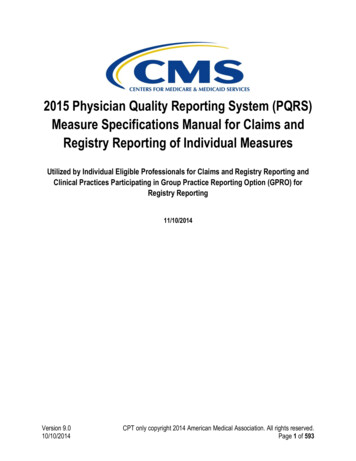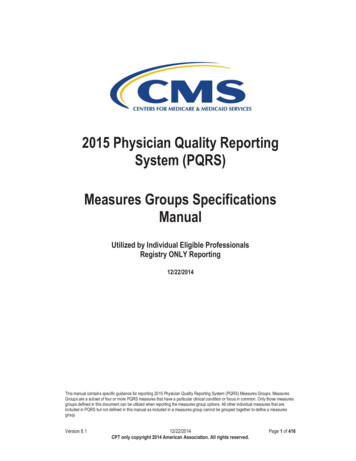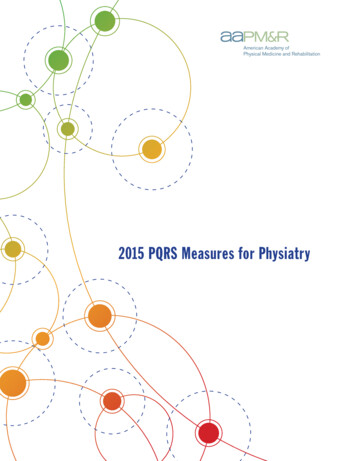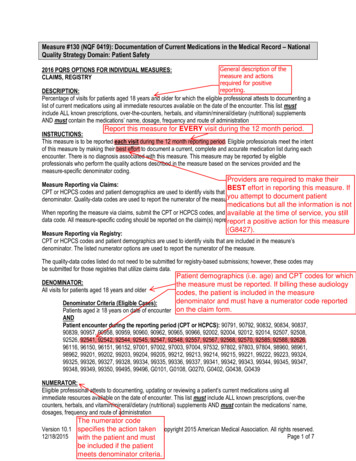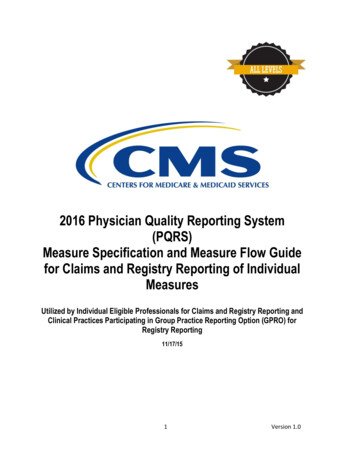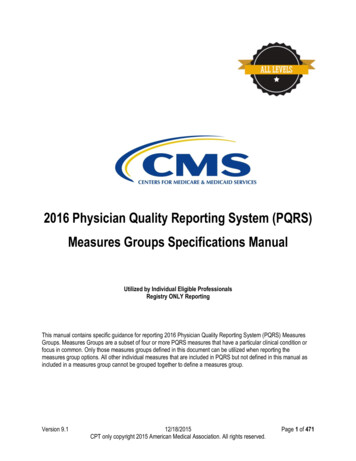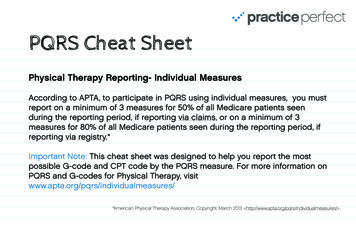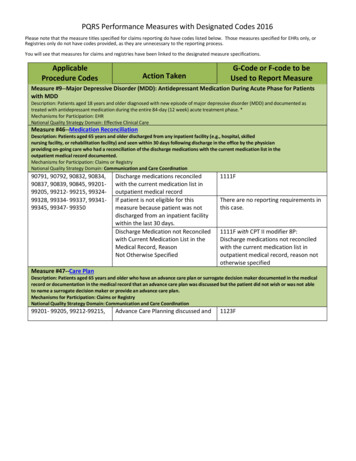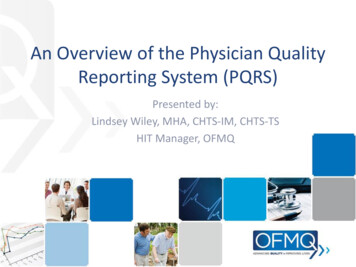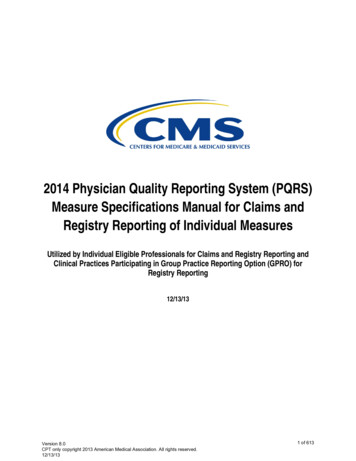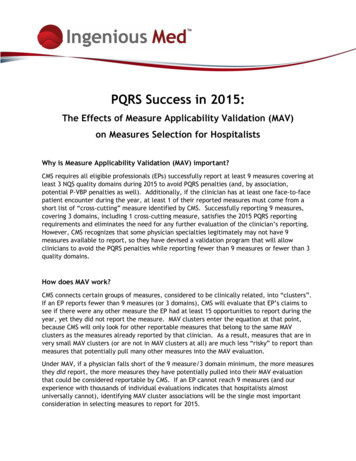
Transcription
PQRS Success in 2015:The Effects of Measure Applicability Validation (MAV)on Measures Selection for HospitalistsWhy is Measure Applicability Validation (MAV) important?CMS requires all eligible professionals (EPs) successfully report at least 9 measures covering atleast 3 NQS quality domains during 2015 to avoid PQRS penalties (and, by association,potential P-VBP penalties as well). Additionally, if the clinician has at least one face-to-facepatient encounter during the year, at least 1 of their reported measures must come from ashort list of “cross-cutting” measure identified by CMS. Successfully reporting 9 measures,covering 3 domains, including 1 cross-cutting measure, satisfies the 2015 PQRS reportingrequirements and eliminates the need for any further evaluation of the clinician’s reporting.However, CMS recognizes that some physician specialties legitimately may not have 9measures available to report, so they have devised a validation program that will allowclinicians to avoid the PQRS penalties while reporting fewer than 9 measures or fewer than 3quality domains.How does MAV work?CMS connects certain groups of measures, considered to be clinically related, into “clusters”.If an EP reports fewer than 9 measures (or 3 domains), CMS will evaluate that EP’s claims tosee if there were any other measure the EP had at least 15 opportunities to report during theyear, yet they did not report the measure. MAV clusters enter the equation at that point,because CMS will only look for other reportable measures that belong to the same MAVclusters as the measures already reported by that clinician. As a result, measures that are invery small MAV clusters (or are not in MAV clusters at all) are much less “risky” to report thanmeasures that potentially pull many other measures into the MAV evaluation.Under MAV, if a physician falls short of the 9 measure/3 domain minimum, the more measuresthey did report, the more measures they have potentially pulled into their MAV evaluationthat could be considered reportable by CMS. If an EP cannot reach 9 measures (and ourexperience with thousands of individual evaluations indicates that hospitalists almostuniversally cannot), identifying MAV cluster associations will be the single most importantconsideration in selecting measures to report for 2015.
Example 1 (Bad MAV): A clinician has decided to report measures A, B, and C (and only those measures) for 2015.Each of those measures belongs to a MAV cluster that results in several additional measures (D, E, F, G, H, I, J, andK) entering the clinician’s MAV evaluation. If CMS finds (through analysis of claims paid to that clinician) that evenone of those additional measures had been reportable at least 15 times during the program year, this clinician willfail the MAV process and incur the PQRS penalty.Cluster 1D E FABCGHI J KCluster 2Cluster 3With this in mind, Ingenious Med’s typical recommendations on what measures a group shouldand should not report in 2015 must take into account the additional considerations that MAVclusters impose. We have revised our advice from previous years – while we used torecommend reporting more measures than you needed, we now recommend NOT attemptingto reach 9 measures and, instead, report only as many measures as you can, while stilllimiting the liability MAV clusters might represent to your success.Example 2 (Good MAV): A clinician has decided to report measures X, Y, and Z (and only those measures) for2015. None of those measures belong to MAV clusters, so no additional measures are evaluated for reportableevents during MAV. This clinician avoids the PQRS penalty while reporting only 3 measures.Measure X has no clustered measuresXYZMeasure Y has no clustered measuresMeasure Z has no clustered measuresIt is possible to (and even more probable that you will) avoid the PQRS penalties by reportingfewer than 9 measures, as long as you select the measures you do report carefully withrespect to MAV clusters.
The flow chart below was taken directly from the 2015 CMS MAV documentation and demonstrates (through thepath highlighted in green) how reporting fewer than 9 measure can enable the EP to pass MAV and avoid the PQRSpenalty – as long as that measures are not in MAV clusters (and contain at least one cross-cutting measure).MAV clusters are different for claims-based and registry-based reporting methodsMAV clusters are defined very differently depending on the method of PQRS data submission aclinician uses for the 2015 reporting period. The MAV clusters defined for the claims-basedreporting and registry-based reporting methods are completely different. As a result,practices should consider their reporting method before they begin reporting any PQRS datain 2015. If they are unsure which method they will use for data submission, their difficulty inpredicting the effects of MAV will potentially be more complicated. There are some measuresthat are “safe” through both reporting methods, but most measures will introduce more MAVliability through one reporting method than the other.
What measures are recommended for inpatient physicians when considering theeffects of MAV?For an inpatient practice, we recommend selecting the following measures, while taking intoconsideration aspects other than their MAV clusters, as detailed in our 2015 Inpatient MeasureEvaluations:47 – Advance Care Plan130 – Documentation of Current Medications317 – Preventive Care: BP ScreeningMeasures #47 and #317 do not belong to MAV clusters in either the claims-based or theregistry-based MAV, so they are excellent choices regardless of the intended submissionmethod. Measure #130 has no clustered measures when reported by registry, but shares aMAV cluster with measures #51 (COPD: Spirometry Evaluation) and #52 (COPD: InhaledBronchodilator Therapy) when reported by claims-based submission. However, measures #51and #52 are only reportable on office H&Ps (99201-99205) and Office Follow-Ups (9921299215), so most inpatient physicians would not have reportable events for those measureswhen they were examined through claims-based MAV. Additionally, each of these 3 measuresare on the CMS list of “cross-cutting” measures, so reporting any one of them would satisfythe cross-cutting reporting requirement for 2015.There are measures listed below that may offer additional reporting opportunities for somegroups, depending upon their clinical scope of practice. Again, the method of submission(claims or registry) will play a large part in selecting any additional measures that can safelybe reported. Each measure selected should either belong to a cluster for which the physiciancan successfully report all other measures in the cluster, or belong to no cluster at all.Table 1: Inpatient measures with limited MAV liability when reported through claimsMeasure32 - Stroke: Discharged on Antithrombotic Therapy47* – Advance Care Plan76 - Prevention of CVC-Related Bloodstream Infections130* – Documentation of Current Medications317* – Preventive Care: BP ScreeningCluster # (add’l measures in cluster)NoneNoneNone3 (51, 52)None* This measure qualifies as a “cross-cutting” measureTable 2: Inpatient measures with limited MAV liability when reported through registryMeasure32 - Stroke: Discharged on Antithrombotic Therapy33 - Stroke: Anticoagulant Therapy Prescribed for AtrialFibrillation at Discharge47* – Advance Care Plan76 - Prevention of CVC-Related Bloodstream Infections130* – Documentation of Current Medications163 - Diabetes: Foot Exam187 - Stroke: Thrombolytic Therapy317* – Preventive Care: BP Screening* This measure qualifies as a “cross-cutting” measureCluster # (add’l measures in cluster)21 (33, 187)21 (32, 187)NoneNoneNoneNone21 (32, 33)None
What about measure recommendations for specialists?Within the framework of PQRS measures, a surprising number of specialist actually havetrigger patterns very similar to hospitalists. However, the extent to which their outpatientbilling (if they do any) is performed outside of the Ingenious Med system can have asignificant effect on their measure selection.If both their inpatient and outpatient charge capture is performed inside of IM (or if theyperform no outpatient services), we can run a trigger analysis of their billing to recommendspecific measures applicable to their practice. Any measures that demonstrate consistenttrigger rates could be considered as options for reporting, taking any MAV clusters potentiallyinvolved into consideration during that process. Registry reporting may be an option for theseusers as well, which also factors into their measure selection (usually in a positive way).If a portion of their charge capture is performed inside of IM and another portion is performedoutside of IM, Ingenious Med could only analyze the portion of their billing captured withinour system. While that will give some indications of which measures the clinician couldreport, there may be other measures reportable by the clinicians that are triggered in theportion of their billing occurring outside of the IM environment, which introduces a degree ofuncertainty into the analysis. Great care would be needed to select measures for thesephysicians, since having measures triggered outside of IM that belong to MAV clusters ofmeasures triggered inside of IM (or vice versa) could be problematic. Reporting through IM’sregistry is not an option for these users, so they would reference the claims-based MAVclusters to evaluate their measures. IM can assist in that evaluation process, but ourrecommendations would be limited in scope, depending on the nature and extent of thecharge capture going on outside of our system.Table 3: Specialist measures with limited MAV liability when reported through claimsMeasure46* - Medication Reconciliation76 - Prevention of CVC-Related Bloodstream Infections110* - Preventive Care and Screening: Flu Vaccine111 - Preventive Care and Screening: PneumoniaVaccination for Patients 65 113 - Colorectal Cancer Screening134* - Preventive Care and Screening: Screening forClinical Depression and Follow-Up Plan154 - Falls: Risk Assessment204 - IVD: Use of Aspirin or Another Antithrombotic* This measure qualifies as a “cross-cutting” measureCluster # (add’l measures in cluster)NoneNoneNoneNoneNoneNoneNoneNone
Table 4: Specialist measures with limited MAV liability when reported through registryMeasure21 - Perioperative Care: Selection of ProphylacticAntibiotics22 - Perioperative Care: Discontinuation of ProphylacticAntibiotics23 - Perioperative Care: Venous Thromboembolism (VTE)Prophylaxis46* - Medication Reconciliation54 - ED: 12-Lead ECG for Non-Traumatic Chest Pain76 - Prevention of CVC-Related Bloodstream Infections110* - Preventive Care and Screening: Flu Vaccine111 - Preventive Care and Screening: PneumoniaVaccination for Patients 65 113 - Colorectal Cancer Screening128* - Preventive Care and Screening: BMI Screening andFollow-Up131* - Pain Assessment and Follow-Up134* - Preventive Care and Screening: Screening forClinical Depression and Follow-Up Plan173 - Preventive Care and Screening: Unhealthy AlcoholUse – Screening204 - IVD: Use of Aspirin or Another Antithrombotic226* - Preventive: Tobacco Screening and CessationIntervention* This measure qualifies as a “cross-cutting” measureAdditional Resources:IM’s 2015 Inpatient Measure EvaluationsMAV clusters for registry submissionMAV clusters for claims-based submissionCMS’s MAV training courseCluster # (add’l measures in cluster)22 (22, 23)22 (21, 23)22 (21, 22)NoneNoneNoneNoneNoneNoneNoneNoneNoneNoneNone
130 – Documentation of Current Medications 317 – Preventive Care: BP Screening Measures #47 and #317 do not belong to MAV clusters in either the claims-based or the registry-based MAV, so they are excellent choices regardless of the intended submission method. Measure #130 has no clustered measures when reported by registry, but shares a
